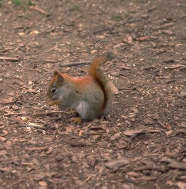Daily Life
 Red squirrels are diurnal and are active for much of the day, often from before dawn until it is dark, pausing only for a midday rest. They have few natural predators so can take the risk of being out in broad daylight. They escape attack from foxes and birds of prey by spending most of their time up in the trees. They forage on the ground for brief spells, particularly in autumn when they collect acorns, beech masts and other nuts to store for winter.
Red squirrels are diurnal and are active for much of the day, often from before dawn until it is dark, pausing only for a midday rest. They have few natural predators so can take the risk of being out in broad daylight. They escape attack from foxes and birds of prey by spending most of their time up in the trees. They forage on the ground for brief spells, particularly in autumn when they collect acorns, beech masts and other nuts to store for winter.
Squirrels hold food in their forepaws. A favourite food is pine cones; they bite the scales off the cones to get at the seeds. The ground under a pine tree may be littered with chewed cones and scales.
When squirrels are not feeding or resting, they are scratching (they are usually covered in fleas!) and washing.
Winter: during the autumn red squirrels eat as much as they can to put on fat reserves for winter. They put on about 12 per cent of their body weight in autumn fat whereas a grey squirrel can put on as much as 25 per cent.
Read More: Breeding